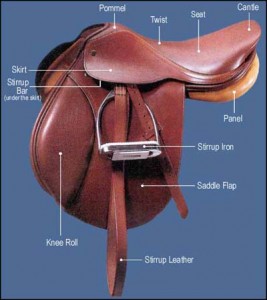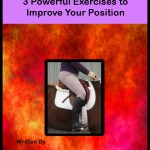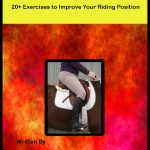Saddle Fitting Basics

![]() photo credit: cmaccubbin
photo credit: cmaccubbin
Having a saddle that fits your horse correctly is half the battle of riding. A saddle that pinches your horse or bears down on his whithers makes the horse uncomfortable and can cause nasty bad habits.
How do you fit a saddle? Here are some basic saddle fitting tips for you to try when you go to purchase your next saddle. Or even take out your present saddle and check its’ fit to make sure it isn’t hurting your horse.
Does your horse object to being saddled? Pinning its’ ears, tail switching, and even kicking out or biting may be indications that there is pain from the saddle. Fitting a saddle is as important as a fitting a pair of shoes. Imagine wearing a pair of shoes that are too tight
The Saddle
- Look at the saddle off the horse. Before even putting the saddle on the horse take a good hard look at it. Is is in good repair. This is especially necessary when you are purchasing a secon hand saddle. Stitching and leather condition are important as is the condition of the saddle padding. It is also important to check the actual structure of the saddle.
- The saddle tree itself should be entact and in good repair. Check the saddle tree by putting the saddle down on a flat surface like the floor or table and make sure that the saddle isn’t tipping or twisting. An off kilter saddle is an indication of a broken or twisted tree and should be avoided.
- Place the saddle on the horse without any padding. Place the saddle well infront of his whithers and slide the
-

Parts of the saddle saddle into place. The saddle should slide into the correct position just behind the horses whithers. At first glance the saddle should clear the whithers. This clearance should be enough to fit approx. 3 fingers. If the saddle tree is too wide the pommel of the saddle will touch and rest on the whithers of the horse. If the saddle is too narrow the pommel will be raised to high and the front panels of the saddle will not be in contact with the horse.
- The saddle should be squarely on the back of the horse with even contact on the back with the panels of the saddle. If the saddle has contact points at the front and back bridging is occuring . This causes pressure points and may lead to sores.
- Make sure that the saddle is level. Sometimes we get a saddle given to us that just isn’t suitable. Often these saddles are low in the seat and puts the rider into a chair seat. Keeping the rider in balance is important and having a level seat is the best way to do this. To test if the saddle seat is level get a simple clinder from an inexpensive pen. Place it on your saddle seat and roll it toward the cantle and pommel until it rests in the deepest part. This should be in the middle of the saddle. If you find the lowest part toward the cantle or back of the saddle it will put you off balance and into a chair seat.
- Check the saddle for stability. Gently place your hand on the seat of the saddle and try to rock the saddle back and forth or to the side. A loose wobbly saddle will smack on the horse’s vack each time you rise out of the saddle. A wobbly saddle will cause rubbing and sores.
Fitting the Saddle to the Rider
Remember that the purpose of the saddle is to distrubute the weight of the rider evenly throughout the horses back and to allow the horse as much flexibility and freedom as possible. To ensure that these points are maintained consider the following tips:
- Is it suitable for your style of riding? Jumping, dressage, saddleseat, endurance all have specialty saddles that you can investigate should you like to pursue a more in depth stream of competition. For general purpose riding a general, all purpose saddle is adequate.
- Does the saddle have the correct length? This is the measurement from the ‘button’ on the saddle just below the pommel to the cantle of the saddle. When sitting in the saddle the rider should have one hand width behind their seat and the edge of the cantle. If you are unable to have a full hand width the saddle is too small and you will be pushed to the front of the saddle. Too much room will cause you to sit out of balance but to the back of thecantle.
- Are the flaps the correct length?
- Does the saddle have the right twist? The saddle’s narrowest part is called the twist or waist and a narrow twist will not be wide enough to support your seat bones. Ensure that the twist is wide enough to support your seat bones without being too uncomfortable.
For more information about saddle fitting and rider fitting read this article which I found very interesting. Fitting a saddle can be a daunting task do ask your coach or trainer to give you some assistance or drop me an email at laura@thistleridgestables.com and I will help as much as I can.
 Try these three powerful exercises to get strengthen your position.
Try these three powerful exercises to get strengthen your position.

Thanks for the comment and the link to my weblog
Thought some other people from my website would prefer to read this